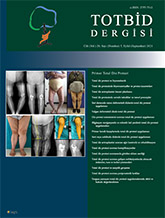
There are various degrees of valgus deformity in 10–15% of patients who have undergone total knee arthroplasty (TKA). Knees with severe valgus deformity constitute 5% of all knee valgus deformities. These are caused by bony abnormalities such as hypoplastic lateral condyle, bone loss in the lateral tibial plateau, external rotation deformity of the tibia, femoral and tibial metaphyseal valgus angulation, and patellar malalignment or soft tissue contractures such as iliotibial band, lateral collateral ligament, posterolateral capsule, posterior cruciate ligament, and popliteus tendon or a combination of both. The presence of both bony and soft tissue abnormalities make TKA surgery challenging in these patients. Combined surgical treatments should be preferred in order to correct soft tissue and bone abnormalities together. The aim of surgery is to obtain a stable and functional lower extremity with adequate soft tissue balance and neutral mechanical axis. The first step in treatment is preoperative clinical and radiological evaluation to detect underlying pathologies. Lateral soft tissue release procedures, adjustment of medial collateral ligament tension, bony cuts and constrained/hinged implant selection can be applied either in combination or individually. Sequential soft tissue release is recommended according to the condition of the valgus knee, instead of applying a standard release procedure. Planning for surgery should be essential in considering the surgeon`s experience, preoperative clinical and radiological evaluation, available implant options, and knee stability.